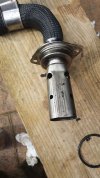Just contributing my experience on this forum (as I have already on the Facebook ones). Regarding giving my DPF a clean whilst still on vehicle.. in the video towards the end you can see the whole load of smoke that came out! And this was on the second clean of the week. I figured doing it twice was worth while.
https://youtu.be/rLY58HXtDNw
I also love the fact that when you tube was parsing the audio it thought the sound of the engine was music. I do have to agree on that one
James
2011 L322 TDV8 4.4
https://youtu.be/rLY58HXtDNw
I also love the fact that when you tube was parsing the audio it thought the sound of the engine was music. I do have to agree on that one
James
2011 L322 TDV8 4.4

 . Cant see the point, or the need.
. Cant see the point, or the need.
